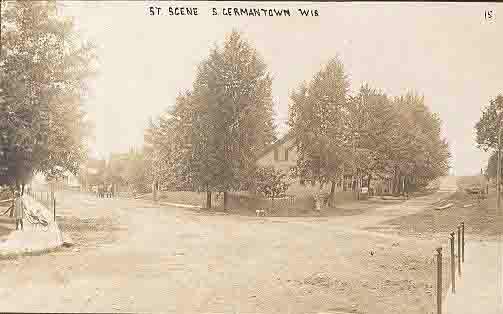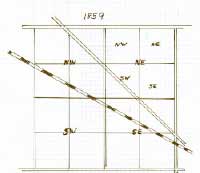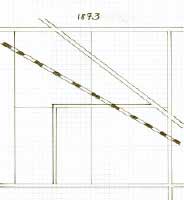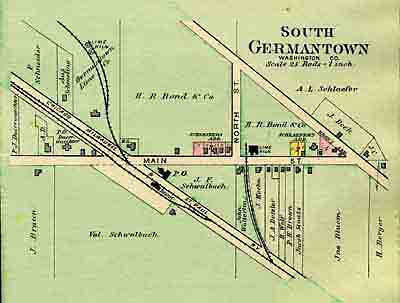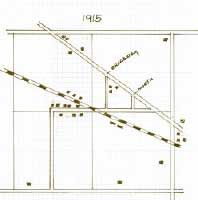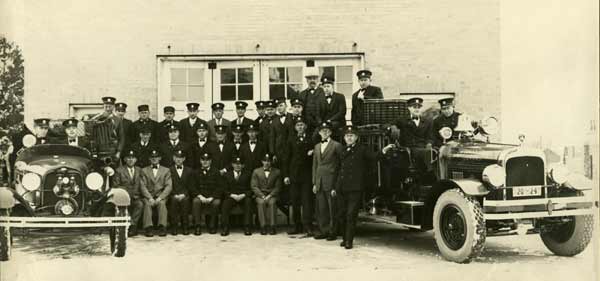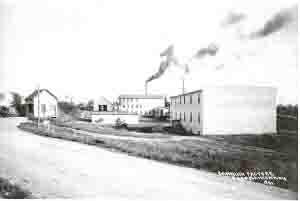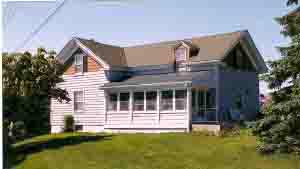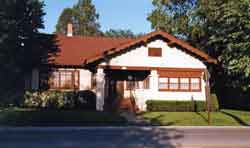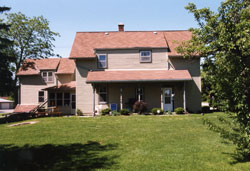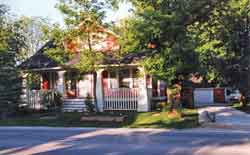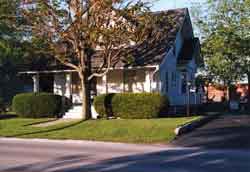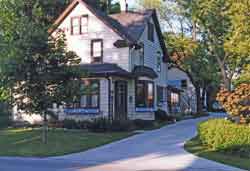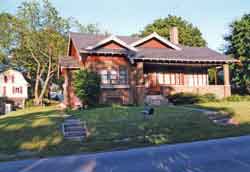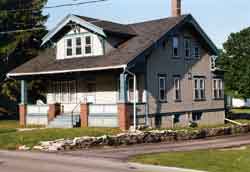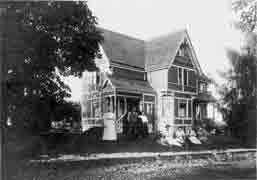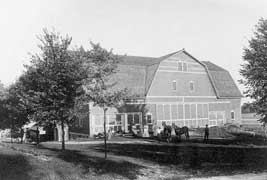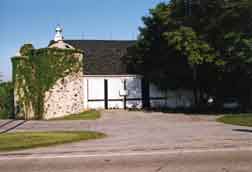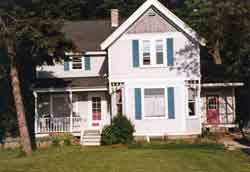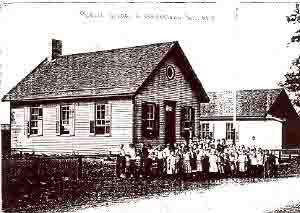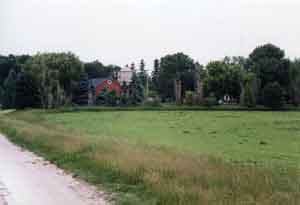|
See Scene 2 of 8 for additional South Germantown village tour information. To see the Germantown Picture Gallery go here.
The village of Germantown did not officially come into existence until 1927. Before this time the area of the original village was known as South Germantown and before that Staatsville. It received the name South Germantown in 1855. Seems that the railroad had two communities named Germantown along its line. One was in Washington County and the other in Juneau County. The Railroad solved this problem by calling the station in Washington County, South Germantown. But this is getting ahead of ourselves. Back in 1839 was seen the first purchases of land in the Township of Germantown or for that matter in Washington County as we know it today. This happened on 11 March 1839 by Anthony D. Wiesner and Levi Ostrander both in Section 35, Samuel Spivey in Section 36 and Freeman Smith in section 34. The village of South Germantown though developed in Section 22. The patentee purchasers in Section 22 were: John Boden (NESW*), Adam Bookman (SESE), Christoph Cramer (SWNE), George Giesmann (SENW), Caspar Kissinger (W1/2SW*), Balser Kripinberger (W1/2SW*), Peter Lauermann (NESE), Mathias Leip (NWSE), Nicholas Mohn (NESW*), Nicholas Peter (SWSE), Jacob Schlaefer (E1/2NE), Dieter Schreier (SESW), Valentine Schwalbach (NWNE-W1/2NW*), Adam Staats (W1/2NW*), and Valentine Staats (NENW). * identifies co-ownership The Township of Germantown was the portal through which settlers first entered Washington County to go to areas in its north and west. When the settlers first came into this area from the south heading north, there were two routes they could take. Fond du Lac Trail moseyed through the center of the township going through what was to become Kuhburg, South Germantown, Dheinsville, then heading north to West Bend. Appleton Trail came into the township towards its southwest from Menomonee Falls, to Willow Creek, up through Meeker Hill, then on to Richfield, heading towards the northwest. While the trail system and the eventual road system were similar, in the beginning at least, they seemed to commingle. It would seem that at times the initial preferred route of travel from Milwaukee to Fond du Lac, the settlers took the Appleton Trail to what was to become Willow Creek, turned right on to "Goldendale Trail", where it begins, following this short trail to Fond du Lac Trail, taking a left on to the Fond du Lac Trail where Goldendale Trail ends. The preferred northern route was the Fond du Lac Trail but not in Germantown. The construction of Fond du Lac Road from what is today Division Road to Goldendale Road seems to have been delayed to sometime after 1859. The preferred route northwest from Milwaukee was on Appleton Trail and in Germantown the preference changed to the Fond du Lac Trail and the cutover from one trail to the other occurred though what was to become Goldendale on what we could call the "Goldendale Trail." Would suspect even in Indian times this was the preferred route, but why? Fond du Lac Trail in Germantown in these early years was not useable 365 days a year for in the springtime it would have been impassable where the Menomonee River crosses it just north of Freistadt Road. The Goldendale "Trail " would have been passable 365 days a year. While the Fond du Lac route was the most direct route south to northwest, it was not always available. This would have impacted the initial settler flow through South Germantown during the spring and after heavy rains. In the early years the area was referred to as Staatsville, then in 1855 South Germantown. It took some years after 1855 before Staatsville, as referring to the community, became a thing of the past. By todays reckoning at the southeast corner of Fond du Lac and Freistadt Roads there existed in the late 1840s the Staats Hotel. This was a drop off and pick up point for mail as well as people. In these years this is where the hub of business transactions and social interaction took place not to mention the enjoyment of a home brewed beer. The hotel is also where the Germantown Farmers Insurance Company initially had their office.
In 1859, Section 22 was owned by: John Kissinger E1/2SWSW+E1/2NESW, B. Neitty NESE, B. Kripinberger W1/2SWSW+W1/2NESW, P. Ries SESE+S1/1SENE, I. Riel SWSE, Jacob Schlaefer E1/2NE+SWNE, Schwalbach NWNE, D. Setuirer SESW, Adam Staats NWNW, and Valentive Staats E1/2NW.
Forward to 1873 and we see: A. Kuhn, J.P. Ruehl, P. Ruehl, J. Schneider, P. Schneider, John F. Schwalbach, A. Staats (brewery), H. Staats (saloon), and J. Staub. Identified were a blacksmith shop, store, and a railroad station.
In 1880, it was reported the Brewery was owned by John Staats and had been in existence since 1852, some 28 years. Mr. Staats died in November of 1880 at which time the business was continued by Ph. G. Duerrwaechter as administrator of the estate. It was also reported there existed in Germantown two lime companies one run by Frank Schlaefer probably what was to become the Cream City Lime Company located in South Germantown and the second, the Germantown Lime Company located in Rockfield. Also present was a store referred to as the depot of Ph. G. Duerrwaechter which sold agricultural implements, lumber, sash, doors and other building material. In conjunction with this business Mr. Duerrwaechter did a large business as a building contractor throughout the county. There was also a store kept by Messrs. Goelzer and Schwalbach. Existing at this time was a cheese factory, the only one in the town, started in May 1881 and was owned and carried on by Schneider and Eimmerman (sic). At this time the Germantown Farmers Insurance Company was located in Dheinsville. The executive officers were President, Andrew Martin and Secretary, Martin Schottler.
In 1912, Carl Quickert in his book Washington County, Wisconsin Past & Present, he describes South Germantown: "A village on the C.M. & St. P. Ry. The industries are: The quarries and kilns of the Cream City Lime company; the condensed milk factory of John P. Gehl; and the brewery of the Vogl Independent Brewing Company. The Germantown Farmer's Insurance Company in the county, owns a fine office building." The insurance company had located [1911] to South Germantown before this time. It would seem that South Germantown came into existence for several reasons: it was a days distance from Milwaukee on the Fond du Lac Trail; it received a railroad station; and it had great limestone formations In the 1840s, the distance from Milwaukee caused South Germantown to exist to service travelers needs along the Fond du Lac Trail. You have the blacksmith shop, the hotel, the saloon as travelers came into the area one day and left on the next. Then came the railroad station in 1855. Now rather than having people to come through the area, they came to the area. The presence of the railroad and the limestone outcoppings cause the lime burning industry to flourish and sustain the community. This industry though did not cause growth. In South Germantown lime burning was king and this existed into the early twentieth century. As lime burning was becoming a thing of the past, the Badger Milk Company came into being and for many years, as was lime burning, it was the dominant industry in the community of South Germantown. The year 1904 saw the first rural mail delivery within the township with Adolph Staats as the mail carrier. In 1927, a 300 acre parcel of land in Section 22 was incorporated as the Village of Germantown. The first president was Herbert Walterlin. Supervisors were Ed Rintelmann and John P. Gehl. Village clerk was H.H. Schneider. Meetings were scheduled on the first Monday of each month. The first meeting was held on 5 May 1927. The second meeting was held on 12 May 1927 at which time:
Richard A. Dehmel was appointed Health Officer
In December of 1921, the Germantown Fire Company donated $2,000 worth of equipment to the Village. In 1929 a new 500 gallon Segrave was purchased from a company in Columbus, Ohio. The Village Board had control of the Segrave when not responding to a fire call. The Fire Chief of the Germantown Fire Company had control of the vehicle when responding to a fire call. At this time the Fire Company identified six engineers: Joseph Rosecky, Herman Siefeld, Laverne Schaetzel, Herman Witzlib, Clarence Schramn and Sam Kraetsch. In 1931 it was decided that only one piece of fire equipment would be allowed to respond to a fire call outside the village while the second fire vehicle must remain within the village. In 1931, sidewalks were designated to be installed along Johns Street. The year 1932, in June, the Village purchased flags and flag poles in the amount of $175.00. These flags were to be used for decoration purposes on legal holidays and special fireman doings. It was noted that the village roadways were layed out on 8 March 1870. The information was obtained from town records. In July 1938 streets within the Village were named. Highway 55 was designated Fond du Lac Avenue. The eastern north/south roadway from highway 55 to Freistadt was named Pleasant Hill Avenue. The east/west main roadway retained the name Main Street. The street just west of Gehls was North Street. The next street west was named Walterlin Street. Johns Street, now called Broadway, remain Broadway. The street to the lime kilns, started between the railroad tracks and Broadway/Main past the saloon to the kilns, was designated Maple Street. In 1935 it was noted that on the latter street there was illegal parking and this needed to be stopped. In 1939, the Germantown Garden Club petitioned the village to plant shrubs and trees along Broadway and Pleasant Hill. The board approved the petition and appropriated $100.00. Later the board amended the appropriation that plantings could be made only in front of homeowners who accepted the change. In the 1930s, 1940s and 1950s each fall the winter skating pond became a subject of board discussions. The discussions did not center on would there be one but where it would be located and who would maintain it. At times it was an artificial pond located within the village. At other times it was Walterlin's quarry. The winter of 1939 must have seen some disorder in its use for following resolution was passed.
"... all on-lookers and patrons using the skating pond shall conduct and
This was identified as resolution #17 and dated 8 January 1940. In February of 1940, the Village Board received a petition with 150 signatures to have the roadway south of Pleasant Hill Avenue which crossed the right of way of the Chicago, Milwaukee, St. Paul and Pacific Railroad opened. The Board accepted the petition and petitioned the Railroad Company to do so. The railroad company refused. The Board then requested the Public Service Commission to order the crossing opened. The commission denied the request. In 1941, the Fire Company requested a liquor license and the request was denied. Over the years the Fire Company was granted a temporary liquor license over the days it conducted its firemans picnic. In 1944, the Board posted a note prohibiting dogs and chickens from running at large. This same year saw the Fire Company petition the village to extend Broadway Street through the park. Gehl's Dairy also petitioned that North Street be closed and the land revert to the company. Eugene Gehl, Clarence Strack, and Clarence Schramn were appointed to the Sports Committee. The committee was appropriated $100.00 to be used for sports activities. December 1945 the Village Board addressed the matter of providing a safe place for boys and girls to sleigh ride. Pleasant Hill Avenue was chosen. It was moved that this roadway would be closed to traffic with a barricade and red lanterns from 4 to 9 pm on such days when coasting was good. The Street Commission was to decide 'when coasting was good' and put up the barricades. This same year Walterlin's quarry was used for skating. The year 1946 was sidewalk year. Petition were received for sidewalks along both sides of Broadway including the new section of this road along Firemans Park, on Fond du Lac from Pleasant Hill Avenue to Main Street and along Church Street previously known as Walterlin Street. This amounted to 4,000 feet of sidewalk and 5,000 feet of curbing which did not include the 1,257 feet of sidewalk and 2,827 feet of curbing along the road adjacent to Firemans Park. As of October 1946, firearms could no longer be discharged in the village. The first petition to close North Street was reject for in 1948 Gehl Company and this time the other abutting property owner (Wolfe) petitioned the closing of North Street. It would seem this petition was successful. This same year the Rotary Club build the Boy Scout cabin in Firemans Park. In this year was seen the first reference in board minutes to Western Avenue. Around 1958, for a year or two, the Germantown Legion Post located on Mequon Road north side midway between Pleasant Hill on the east and Tony Stuettgen on the west sponsored trapshooting behind their facility. Locals and some not so local would come to compete against one another to win Cornish hens. Earl Marks had a very good eye and a beautiful gun. In 1964, a potential catastrophe was about to happen. The city of Milwaukee incorporated several acres of land contiguous to it and in the southeast corner of the Township. To prevent further takeover by Milwaukee, most of the Township was incorporated into the Village. The area primarily around Rockfield chose not to be included. Over time though, some of these unincorporated areas requested incorporation and this was granted. Today the Town of Germantown continues to exists although the land area is very small and not contiguous. The Township of Germantown owns two distinctions, area wise within its border is the largest village and smallest town in the State of Wisconsin. For the most part through the 20st century, Germantown was a farming community and serviced farming needs. In the latter part of the 20st century its status changed from farming to a desirable community in which to locate ones family. The job market was in Milwaukee and Germantown was close by. So as not to rely solely on the Milwaukee economy, as did many of the surrounding communities to Milwaukee, industrial parks were created to provide job opportunities for its citizens and to snare new citizens. This worked well. The makeup of the village is diverse. The southeast portion is densely populated while the further north you go, the more rural it becomes. This is not a factor of distance from Milwaukee but municipal support of water and especially waste disposal. The southeast area is connected up to the Milwaukee Waste System, the rest of the village is not. The impact of this is higher population density in the southeast. On 7 May 1907, the South Germantown Volunteer Fire Company came into being. There were 40 members. Officers were: Chief, Henry V. Schwalbach; 1st Assistant Chief, Frank Schmeling; 2nd Assistant Chief, John Walterlin; and Secretary John A. Strack who served in this position for eighteen years; Treasurer, John P. Gehl, Chemical Foreman, Aaron Walterlin; and, Hook and Ladder Foreman, Frank Schwalbach. The first firehouse in November 1907 was located directly south across the street of what was to become Gehl's and along the east side of the railroad spur. On 21 July 1915 the fire company was incorporated. The company was growing not only in membership but in apparatus so in 1925 a new fire house was built on Church Street where in 2002 a medical clinic stands. Come 24 January 1928, at the annual meeting, the Company changed its name to Germantown Volunteer Fire Company. In 1944, the fire company purchased land from the John Schwalbach estate and turned it into Firemans Park. This turning it into a park was a community effort as the fire department was the community. The land had been a farm and was pretty much treeless. One of the first activities was to plant trees. The trees about 4-6 inches in diameter came from the Hauser and Heltz farms. They were dug up from these farms and replanted in the park. Beds were also planted. Two to three beds were assigned to each fireman's family to maintain. This amounted to edging and periodically preparing the soil. As there were many gophers in the park with their holes everywhere, boys in their teens had the duty to pour water down these holes and when the gopher attempted to escape, boys with sticks chased it down. Many were removed from the park in this fashion. In the south 1/3 of the park, a full fledged ball diamond was established in the southeast corner and a small ball diamond for the children was build on the southwest corner. The trees and beds were position in the middle 1/3 of the park while the north 1/3 was not developed. In 1956, in this park was built a new fire station replacing the station on Church Street. In 1990 the Volunteer Fire Company was dissolved.
On 11 March 1927, South Germantown became the Village of Germantown. Eleven citizens of the village had petitioned the Washington County Circuit Court for incorporation of a 300 acre parcel of land in Section 22. This 300 acres was positioned 40 acres north of the south border, 40 acres east of the west border (Western Avenue), 20 acres south of the north border and its east border was the east border. The petitioners were: Father Banholzer, Adam Diefenthaler, Benn C. Duerrwaechter, Alvin Gronemeyer, Edward Rintelman, Joe Rosecky, Arthur Schmidt, Charles A. Schuster, John A. Schwalbach, Joseph John Siegl, and Aaron Walterlin. Population of South Germantown, now Germantown, was 243. Herbert Walterlin became village President and Harry Snyder village Clerk. When Mr. Snyder resigned, Oliver Gehl became Clerk. In 1929 Charley Schuster became President and Fred Mehre Clerk a position he held for 25 years. Around 1930, some Germantown retailers and residences in the first half of the 20th century as remembered by Edith Mehre. In later years, as remembered by Daniel Sennott, Fred Mehre Jr., and Donald Schulteis
Officially, everyone who lived east of Pleasant Hill was a Town of Germantown resident. See Scene 2 of 8 for additional South Germantown village tour information. To see the Germantown Picture Gallery go here. |
